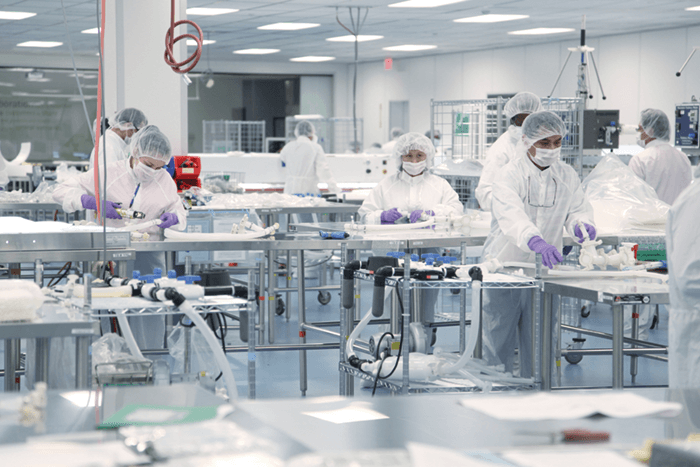Although many new treatment modalities are emerging, monoclonal antibodies (mAbs) remain dominant in late development pipelines. Batch processing is the main method of mAb manufacture today, but as the mAb molecule is highly conserved in terms of how it is expressed and purified, it lends itself well to industrialization. In other words, mAb molecules are perfect candidates for continuous bioprocessing, where there are real opportunities to improve efficiency, speed and cost reduction. After all, it is no longer sufficient to have a biomolecule that simply works – or a bioprocess that focuses only on meeting existing demand, no matter the cost. Manufacturers are being pressured by governments and payers to lower drug costs. At the same time, there is increasing competition from biosimilars. To bring down costs, the mAb factory of the future will need to have a smaller footprint and lower cost infrastructure. It must also be much more efficient in terms of how it produces drug product. Achieving all of these goals requires a rethink of the bioprocess itself, including how the molecule is manufactured in terms of system – stainless steel, single use, or a combination of both – how the plant is controlled through software and automation systems, and how analytics can reduce the burden of quality control testing. Many different fields are coming together now – and industry 4.0 is a big buzz word – but one of our main areas of focus is on improving the process. Traditional batch manufacture is notoriously inflexible. The mAb manufacturing industry needs a process that can meet the demands of today, while being flexible enough to meet the demands of the future, as new markets open up. There is a natural evolution taking place in the industry as companies strive for next-generation bioprocessing – and in many cases it leads to continuous bioprocessing.

Stepwise evolution
The first step in this bioprocess evolution is process intensification – where individual unit operations are brought up to the best possible performance in the lowest footprint. Right now, there is a lot of work taking place in the industry around perfusion technologies for bioreactors, either during the seed train or at the production scale to maximize product titer at the time of harvest, or to perform a continuous harvest that results in more product over more days – essentially by running the bioreactor in a continuous mode. There is also a lot of focus on the capture step, with some companies looking at fixed bed technology for protein A. At Merck, we are using a membrane technology that incorporates protein A, allowing more rapid processing and higher flow rates. There are also other effective technologies, such as multi-column chromatography systems, which involve several smaller columns that allow for higher productivity of the resin through higher flow rates and cycling of the columns. After process intensification, the individual unit operations must be connected. Right now, drug product is pooled between each unit operation. Ideally, the industry wants to reach the point where product flows continuously. Performing cation exchange, anion exchange, virus filtration, and even virus inactivation in continuous flow through mode, for example, would significantly reduce resin requirements and save a lot of time and floor space. The final step – which I think everyone in the industry is looking forward to – is a fully continuous process, incorporating a perfusion bioreactor, or the expression of the product, as well as a downstream process where each unit operation flows directly into the next in the chain. Such levels of integration are beyond what anyone can provide right now, and before we get there, we need innovation in analytics, software and control schemes. We really need to understand how processes will operate and be controlled when in fully continuous mode. It’s early days but progress is rapid. In the small molecule world, there has already been a huge drive towards continuous processing, which is leading to innovation in regulatory processes. Many regulatory questions around continuous manufacture will likely be resolved by the time the industry is truly ready to adopt continuous bioprocessing. Indeed, much of the work we’re doing focuses on answering key regulatory questions around process validation – particularly, viral clearance and validation of viral clearance in a continuous and connected process. And regulators are very supportive of our activities in this area.Modeling success
As the move towards connected and continuous processing continues, more process models are coming to market. We have been working with Biopharm Services and using their BioSolve tool – a process modeling tool that can holistically examine a full process and the facility around it to understand what the major cost drivers are. We have created models for connected and continuous processes that allow us to test our technologies and obtain hard data about how they will affect the full process. We then focus on the technologies that give the greatest returns in terms of process efficiency and cost reduction for our customers. Our process models can also be used to assess the impact of changes or new technologies on a process, as well as overall running costs. If you look at the overall cost of manufacturing a mAb, the contribution that a company like Merck makes is through the cost of consumables, such as cell culture media, filters and single-use components – roughly 7–12 percent of the overall cost of the manufacturing process. However, we really want to understand how our technology impacts the other 88 percent of manufacturing costs. For example, using single-use systems can eliminate steam-in-place, which saves having to install a boiler, and lowers the overall cost of the facility. It’s really important for us to understand the value that our technology delivers in terms of process costs – and we are busy collecting data to support our mission. We have already intensified downstream unit operations through the introduction of membrane adsorbers, flow-through aggregate removers and the cation exchange step, and if we connect the processes we also see higher value overall. At the beginning of June, I gave a webinar on this topic where I revealed some well validated proof points. You can watch the recorded on-demand webinar here.Why continuous matters
The importance of continuous bioprocessing has been recognized by the BioPhorum Operations Group (BPOG), which released its Biomanufacturing Technology Road Map last year. The road map represents a true concerted effort from the industry as a whole – both suppliers and manufacturers – to identify a future process that can help achieve the important cost and efficiency goals of manufacturers. To create the road map, the consortium examined expected market trends for the next 5–10 years, and then asked how the industry would subsequently need to adapt its manufacturing processes. They put together a series of process scenarios, including small-scale clinical production, large-scale production, retrofitting existing facilities to use intensified and connected types of technologies, and a fully continuous process. For each scenario, they outlined what types of solutions would be required, the product demand, and upstream process volumes. The road map has put vendors in a position where they are being asked to produce specific new technologies that really push the envelope in terms of what’s achievable, rather than trying to guess what we should do next as a supplier. At Merck, we are producing our own roadmaps around technologies and products that we know we will need to provide to the industry in the next 5–10 years, so that the industry can truly enhance its processes. The next few years will be really exciting. There is a huge drive in the industry to collaborate in the field and a lot of the key technologies are close to the implementation phase. Next-generation bioprocesses involving intensified, connected and continuous processes will optimize manufacturing and bring down costs, and allow companies to provide more products to more patients around the world. For me, this isn’t just about hope or aspiration, but a moral imperative that governs what we need to achieve as an industry to cure disease. Michael Felo is Director, Downstream Process Integration, Next Generation Processing at Merck. The life science business of Merck operates as MilliporeSigma in the US and Canada.
Although many new treatment modalities are emerging, monoclonal antibodies (mAbs) remain dominant in late development pipelines. Batch processing is the main method of mAb manufacture today, but as the mAb molecule is highly conserved in terms of how it is expressed and purified, it lends itself well to industrialization. In other words, mAb molecules are perfect candidates for continuous bioprocessing, where there are real opportunities to improve efficiency, speed and cost reduction. After all, it is no longer sufficient to have a biomolecule that simply works – or a bioprocess that focuses only on meeting existing demand, no matter the cost. Manufacturers are being pressured by governments and payers to lower drug costs. At the same time, there is increasing competition from biosimilars. To bring down costs, the mAb factory of the future will need to have a smaller footprint and lower cost infrastructure. It must also be much more efficient in terms of how it produces drug product. Achieving all of these goals requires a rethink of the bioprocess itself, including how the molecule is manufactured in terms of system – stainless steel, single use, or a combination of both – how the plant is controlled through software and automation systems, and how analytics can reduce the burden of quality control testing. Many different fields are coming together now – and industry 4.0 is a big buzz word – but one of our main areas of focus is on improving the process. Traditional batch manufacture is notoriously inflexible. The mAb manufacturing industry needs a process that can meet the demands of today, while being flexible enough to meet the demands of the future, as new markets open up. There is a natural evolution taking place in the industry as companies strive for next-generation bioprocessing – and in many cases it leads to continuous bioprocessing.

Stepwise evolution
The first step in this bioprocess evolution is process intensification – where individual unit operations are brought up to the best possible performance in the lowest footprint. Right now, there is a lot of work taking place in the industry around perfusion technologies for bioreactors, either during the seed train or at the production scale to maximize product titer at the time of harvest, or to perform a continuous harvest that results in more product over more days – essentially by running the bioreactor in a continuous mode. There is also a lot of focus on the capture step, with some companies looking at fixed bed technology for protein A. At MilliporeSigma, we are using a membrane technology that incorporates protein A, allowing more rapid processing and higher flow rates. There are also other effective technologies, such as multi-column chromatography systems, which involve several smaller columns that allow for higher productivity of the resin through higher flow rates and cycling of the columns. After process intensification, the individual unit operations must be connected. Right now, drug product is pooled between each unit operation. Ideally, the industry wants to reach the point where product flows continuously. Performing cation exchange, anion exchange, virus filtration, and even virus inactivation in continuous flow through mode, for example, would significantly reduce resin requirements and save a lot of time and floor space. The final step – which I think everyone in the industry is looking forward to – is a fully continuous process, incorporating a perfusion bioreactor, or the expression of the product, as well as a downstream process where each unit operation flows directly into the next in the chain. Such levels of integration are beyond what anyone can provide right now, and before we get there, we need innovation in analytics, software and control schemes. We really need to understand how processes will operate and be controlled when in fully continuous mode. It’s early days but progress is rapid. In the small molecule world, there has already been a huge drive towards continuous processing, which is leading to innovation in regulatory processes. Many regulatory questions around continuous manufacture will likely be resolved by the time the industry is truly ready to adopt continuous bioprocessing. Indeed, much of the work we’re doing focuses on answering key regulatory questions around process validation – particularly, viral clearance and validation of viral clearance in a continuous and connected process. And regulators are very supportive of our activities in this area.Modeling success
As the move towards connected and continuous processing continues, more process models are coming to market. We have been working with Biopharm Services and using their BioSolve tool – a process modeling tool that can holistically examine a full process and the facility around it to understand what the major cost drivers are. We have created models for connected and continuous processes that allow us to test our technologies and obtain hard data about how they will affect the full process. We then focus on the technologies that give the greatest returns in terms of process efficiency and cost reduction for our customers. Our process models can also be used to assess the impact of changes or new technologies on a process, as well as overall running costs. If you look at the overall cost of manufacturing a mAb, the contribution that a company like MilliporeSigma makes is through the cost of consumables, such as cell culture media, filters and single-use components – roughly 7–12 percent of the overall cost of the manufacturing process. However, we really want to understand how our technology impacts the other 88 percent of manufacturing costs. For example, using single-use systems can eliminate steam-in-place, which saves having to install a boiler, and lowers the overall cost of the facility. It’s really important for us to understand the value that our technology delivers in terms of process costs – and we are busy collecting data to support our mission. We have already intensified downstream unit operations through the introduction of membrane adsorbers, flow-through aggregate removers and the cation exchange step, and if we connect the processes we also see higher value overall. At the beginning of June, I gave a webinar on this topic where I revealed some well validated proof points. You can watch the recorded on-demand webinar here.Why continuous matters
The importance of continuous bioprocessing has been recognized by the BioPhorum Operations Group (BPOG), which released its Biomanufacturing Technology Road Map last year. The road map represents a true concerted effort from the industry as a whole – both suppliers and manufacturers – to identify a future process that can help achieve the important cost and efficiency goals of manufacturers. To create the road map, the consortium examined expected market trends for the next 5–10 years, and then asked how the industry would subsequently need to adapt its manufacturing processes. They put together a series of process scenarios, including small-scale clinical production, large-scale production, retrofitting existing facilities to use intensified and connected types of technologies, and a fully continuous process. For each scenario, they outlined what types of solutions would be required, the product demand, and upstream process volumes. The road map has put vendors in a position where they are being asked to produce specific new technologies that really push the envelope in terms of what’s achievable, rather than trying to guess what we should do next as a supplier. At MilliporeSigma, we are producing our own roadmaps around technologies and products that we know we will need to provide to the industry in the next 5–10 years, so that the industry can truly enhance its processes. The next few years will be really exciting. There is a huge drive in the industry to collaborate in the field and a lot of the key technologies are close to the implementation phase. Next-generation bioprocesses involving intensified, connected and continuous processes will optimize manufacturing and bring down costs, and allow companies to provide more products to more patients around the world. For me, this isn’t just about hope or aspiration, but a moral imperative that governs what we need to achieve as an industry to cure disease. Michael Felo is Director, Downstream Process Integration, Next Generation Processing at MilliporeSigma. The life science business of Merck operates as MilliporeSigma in the US and Canada.




